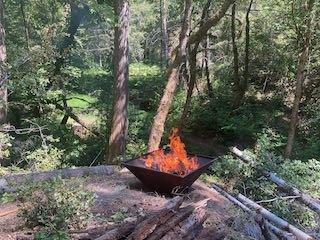Find out how much carbon you’re drawing down by making biochar
Read moreThe Products of Pyrolysis
A guide to the solids, liquids and gases that can be made from biomass
Read moreNo Burn Scars From Char
Three months after a kiln burn at my place
If you burned the char, you'd burn the soil. But that's exactly what you're preventing.
Read moreAir Curtain Burners Now Exempt!
EPA has just exempted air curtain burners that make biochar
Read morePhotos from Pole Building Workshop
Natural builder Colin Gillespie of Laytonville teaching pole harvest and construction using local materials
Read moreBiochar Demo at 2024 Arcata Seed & Scion Exchange
Gray Shaw prepares the group for what they are about to experience
Representing the Institute for Sustainable Forestry with educational demonstration of biochar-making
Read moreAll-Day Biochar Workshop CANCELLED
Full day of instruction and learning by burning, turning excess forest material into a powerful soil amendment
Read moreNotes Following a Biochar Talk
Follow-up notes for a talk given to a local group, explaining biochar and why I make it
Read moreCruising for Poles
All-day workshop about selecting fir trunks in the forest for pole construction, 2/24/24
Read moreBiochar is Charcoal
Resolving the semantics about pyrolyzed biomass
Read moreThe Soil's the Limit on Adding Biochar
How much biochar should you add to your soil? The answer hinges on an understanding of biochar.
Sand, clay and silt consist of minerals. They provide a substrate for the formation of organic complexes, which bind the soil particles. Very slow weathering and dissolution by microbes can bring minerals into circulation in the soil food web. Biochar is not a mineral, but it behaves the same way. Like minerals, it is inert in the soil. However, it has a vastly greater surface-to-volume ratio. This is what supercharges soil life and productivity.
Biochar does not directly enhance soil productivity. Its tremendous contribution to soil ecology is indirect, through increasing the surface area required by the organic complexes that constitute soil life.
Our recent trials indicate that biochars that are engineered to build soil carbon and placed in the rhizosphere and … applied every year … can build an extra 1 tonne of carbon in 1-2 years. Suggest you read Han Weng's work on this which we summarised in Joseph et al. (2021), How biochar works, and when it doesn't: A review of mechanisms controlling soil and plant responses to biochar.
– Stephen Joseph PhD, Renewable Energy and Biochar Researcher and Consultant, UNSW
Any char is good. Some are better. Cooking at above 450°C provides permanence. Below that more SOC (food) but less biochar (structure).
– Albert Bates, coauthor of Burn and Terra Preta
Low temperature biochars can have a long lifetime if they form an organomineral coating on their surface and are taken into the soil microaggregate structure. This often occurs quickly in many tropical and sub tropical soils that have a high clay content.
– Stephen Joseph
How much is enough? The limit depends on whether labile organic matter (food) and water are in good supply. You will read that diminishing returns and possibly even lower yields start above 10% biochar by volume in the root zone. This may be because mineral availability begins to become limiting above that percentage. However, the exact level will probably depend on your mineral soil structure, so your mileage might vary accordingly. Best to conduct experiments in your own garden.
Is Biochar Green?
Trapezoidal Kon-Tiki kiln design
Biochar is neither green nor not, but methods make it so
Read moreIntroduction to Biochar
Trying out a garden shredder for grinding char.
Lessons from the Biochar Road Show
Read moreBiochar Basics
Interview of Gray Shaw and Susan Nolan for KMUD’s “Burning Issues” program in March 2020, covering points presented during their “Biochar Road Show”
Read moreDrought Hardening with Biochar
Water retention can buffer droughts caused by climate change
Read moreIndigenous Fire and Lifestyle
This fascinating and wide-ranging interview on Native American landscape practices was produced for the Institute for Sustainable Forestry and aired on KMUD (Redway, CA).
Read moreGirdling Douglas-firs
I wrote and presented a half-hour radio program as part of ISF’s Sustainable Forestry Journalism Project, centered on girdling Douglas-firs for ecological restoration and fire safety.
Read moreThe People's Drawdown
Mother Jones published a feature article in December 2019 about solutions to climate change with NO mention of biochar. It was mainly about the need for R&D in alternatives to fossil fuel. Pyrolysis was mentioned, but only in conjunction with new tree plantations. So, I wrote and set them straight.
Read moreForest Management for Fire – Nov. 2018 FB thread
“T Gray Shaw do you mind commenting on what we could do to manage forests to mitigate and control what seems like a growing issue in the west?”
Read moreRegenerative Cannabis Farming
The crop looks good—deep green and perky, no drooping or yellowing, better than it has looked in years. This (2019) was the year we went "all in," using biochar as an amendment for every plant.
Read more






